LG 34UM67: UltraWide FreeSync Review
by Jarred Walton on March 31, 2015 3:00 PM ESTLG 34UM67 Display Uniformity
Given the size of the display, creating good uniformity can be difficult. Most of the display does reasonably well, with the corners tending to vary a bit more the center. The left side of our sample in particular looks a bit dim, but it’s only something you really notice when you look for it.
Starting with white uniformity, the center ends up being close to the brightest area, when most other sectors dropping off slightly. The center portion along with the bottom are all within 10%, which is a good result, but the top left and right corners fall off by up to 15%. Professionals would appreciate better uniformity overall, but for gaming the LG 34UM67 works well.
Black uniformity interestingly is a bit of a reverse from the white, with many areas showing slightly higher black levels than the center. However, our i1 Pro is not the best device for measuring black levels and the actual difference between 0.315 cd/m2 and 0.387 cd/m2 isn’t all the great when looking with your physical eyes, even though it’s a 23% difference. There’s a lot of variability in the charts, but mostly the corners seem to be the biggest outliers.
Compared to our earlier calibrated results, or uniformity contrast measurements have all fallen off quite a bit. Our measured contrast this time ranges from 465:1 on the bottom-right corner to as high as 662:1 just above the center, but I think most of the black levels were measured too high so the contrast results are only moderately useful.
Delta E shows similar uniformity again. The top-left edge and top-right seem to have the greatest variance, but for a non-professional display most of this discussion is academic.
The short summary is that uniformity on the LG 34UM67 is good but not exceptional. There will obviously be differences between panels, so where we had problems primarily on the corners and left/right edges, other displays may show more or less issues. Perhaps the most telling aspect is that prior to testing uniformity, I looked carefully over the display with a variety of solid background images to see if I could detect any problems. There are some very minor discolorations that show up primarily when viewing pure white, but the size of the display makes the corners more of an acute viewing angle so it often feels like that’s as big of a problem as display uniformity.


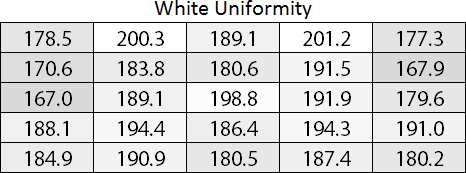
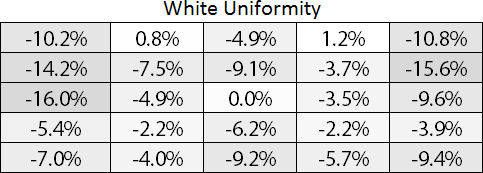
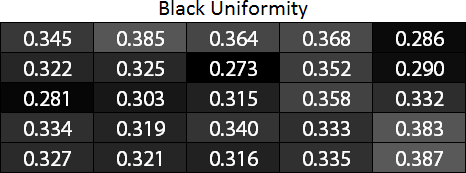
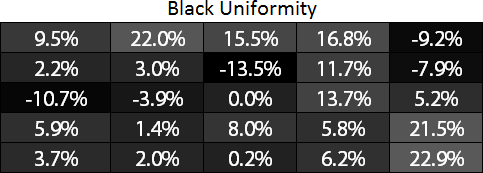
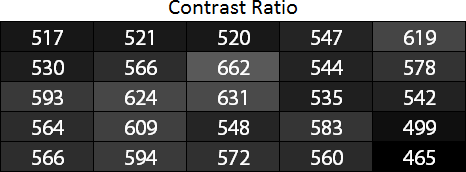
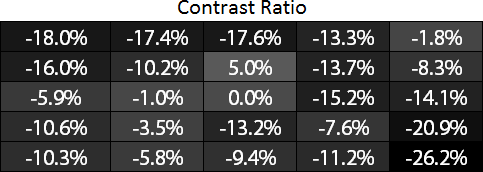
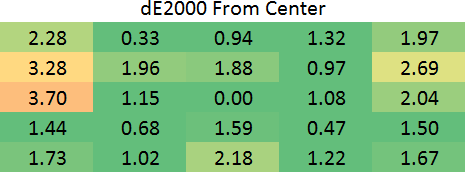








96 Comments
View All Comments
xthetenth - Wednesday, April 1, 2015 - link
For working purposes I would not consider a 16:x 4k an upgrade from 3440x1440 at all. I would be trading sufficient x space to have a third item up or a wide item and a narrow one up at the same time in return for a small amount of y space that doesn't make a meaningful difference. Past roughly 1200 pixels tall, 21:9 is by far the best aspect ratio for work. By 1200 pixels, there's plenty of y space that added information by increasing y space is facing seriously diminishing returns, while x space is starting to go from two pretty wide windows to three windows side by side, which is still giving significant returns.Of the current selection of monitors, I would definitely choose 3440x1440 to keep for 5 years, and spending that much tends to come with a very nice, calibrated screen. A $300-$400 2560x1440 isn't the same quality screen.
wweeii - Tuesday, March 31, 2015 - link
Theoretically even if you drop below 48hz it shouldn't be all bad.Between 16 and 24 fps, you can just triple the refresh rate, 48-75hz would work just fine without tearing.
Between 24 and 37 fps, you double the refresh rate, so no problem either.
You would only have a problem between 37 to 48 FPS, which is unfortunate.
Soulwager - Tuesday, March 31, 2015 - link
But AMD isn't doing that, and the VRR window is too small to do window shifting. If you want to display every frame on time you need a max frame interval needs to be greater than your frametime variance plus double the minimum frame interval.Soulwager - Tuesday, March 31, 2015 - link
You can test input lag with inexpensive hardware, for example, an arduino with native USB that emulates a mouse input and measures a subsequent brightness change with a photoresistor.Ryan Smith - Tuesday, March 31, 2015 - link
If you could, please shoot me an email.Soulwager - Tuesday, March 31, 2015 - link
Done.OrphanageExplosion - Wednesday, April 1, 2015 - link
Is there a link with an explanation for this somewhere so we can all take a look at this idea?Soulwager - Thursday, April 2, 2015 - link
Yes, here's a forum post: http://forums.blurbusters.com/viewtopic.php?f=10&a...jjj - Tuesday, March 31, 2015 - link
This gave me an idea, a Cypress PSoC board instead of Arduino could also work and maybe you could make a similar device to test touch responsiveness in phones and tabs. Cypress makes touch controllers so maybe they would help you out with some coding to enable you to test touch responsiveness. You could at least try. Guess Arduino started with Atmel chips and Atmel is also one of the major touch controller players so you could try to ask for their help too.cbrownx88 - Tuesday, March 31, 2015 - link
Yes - please email him! lol